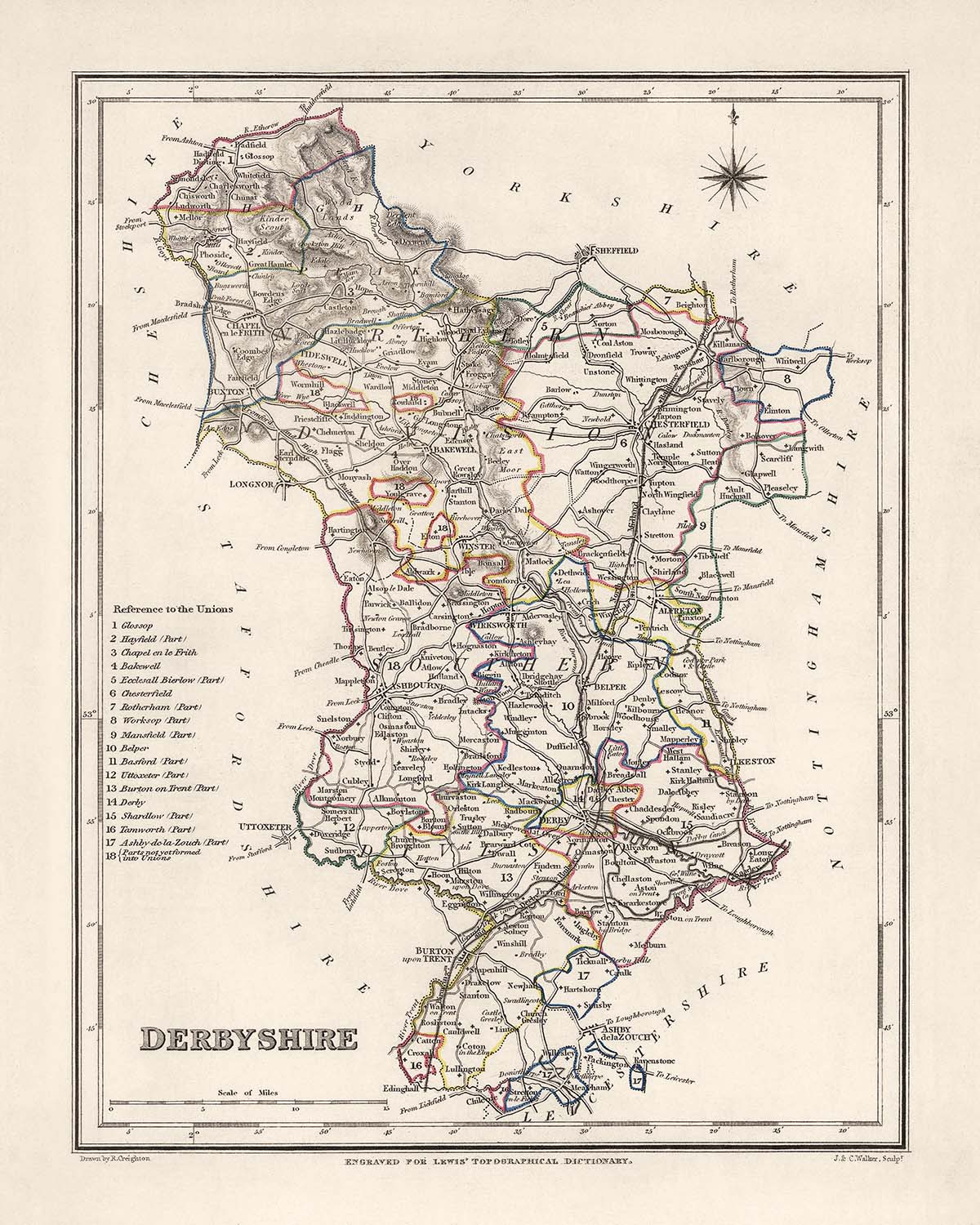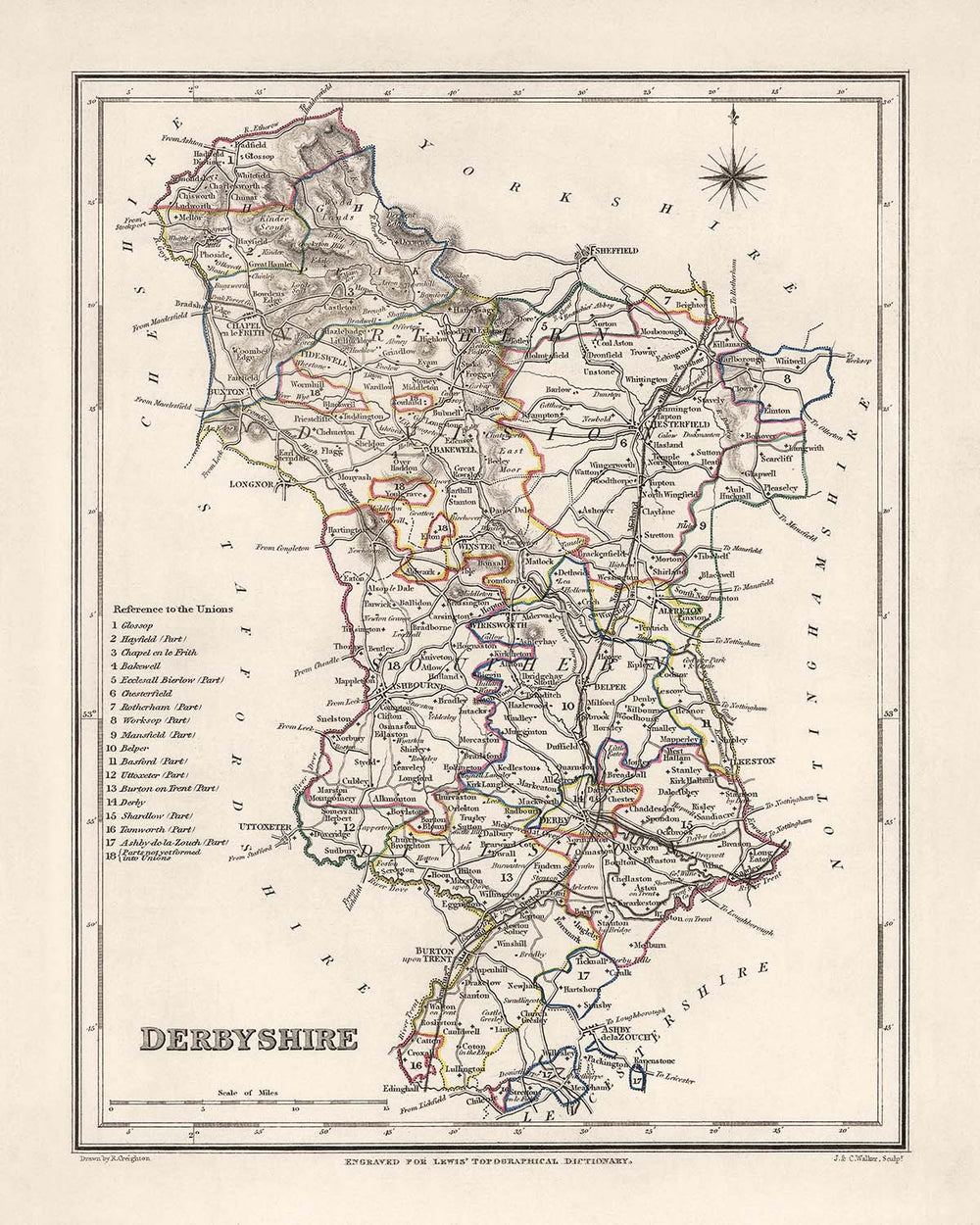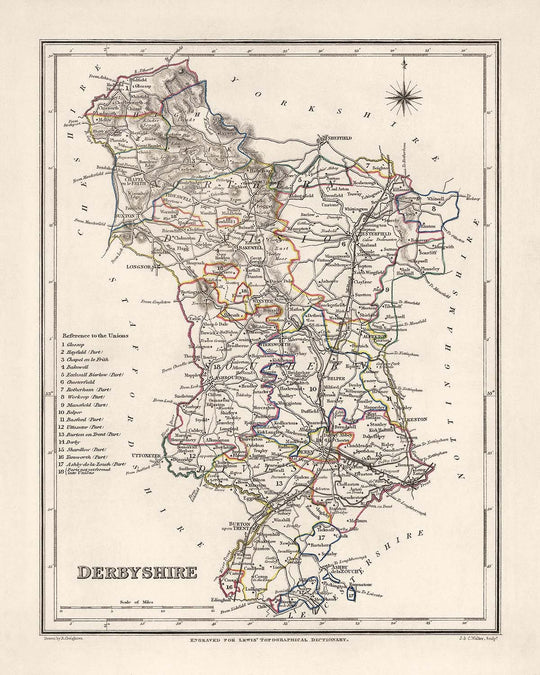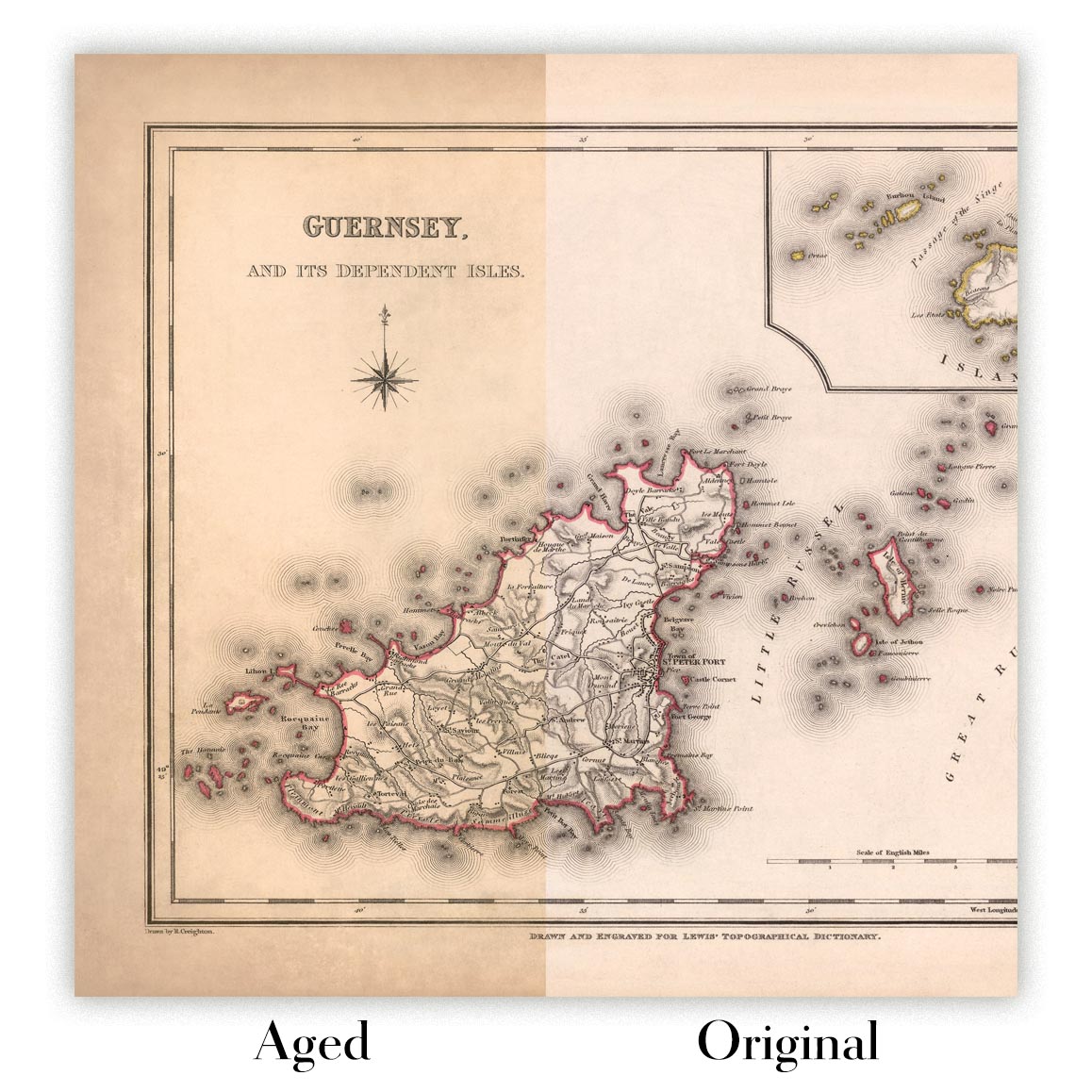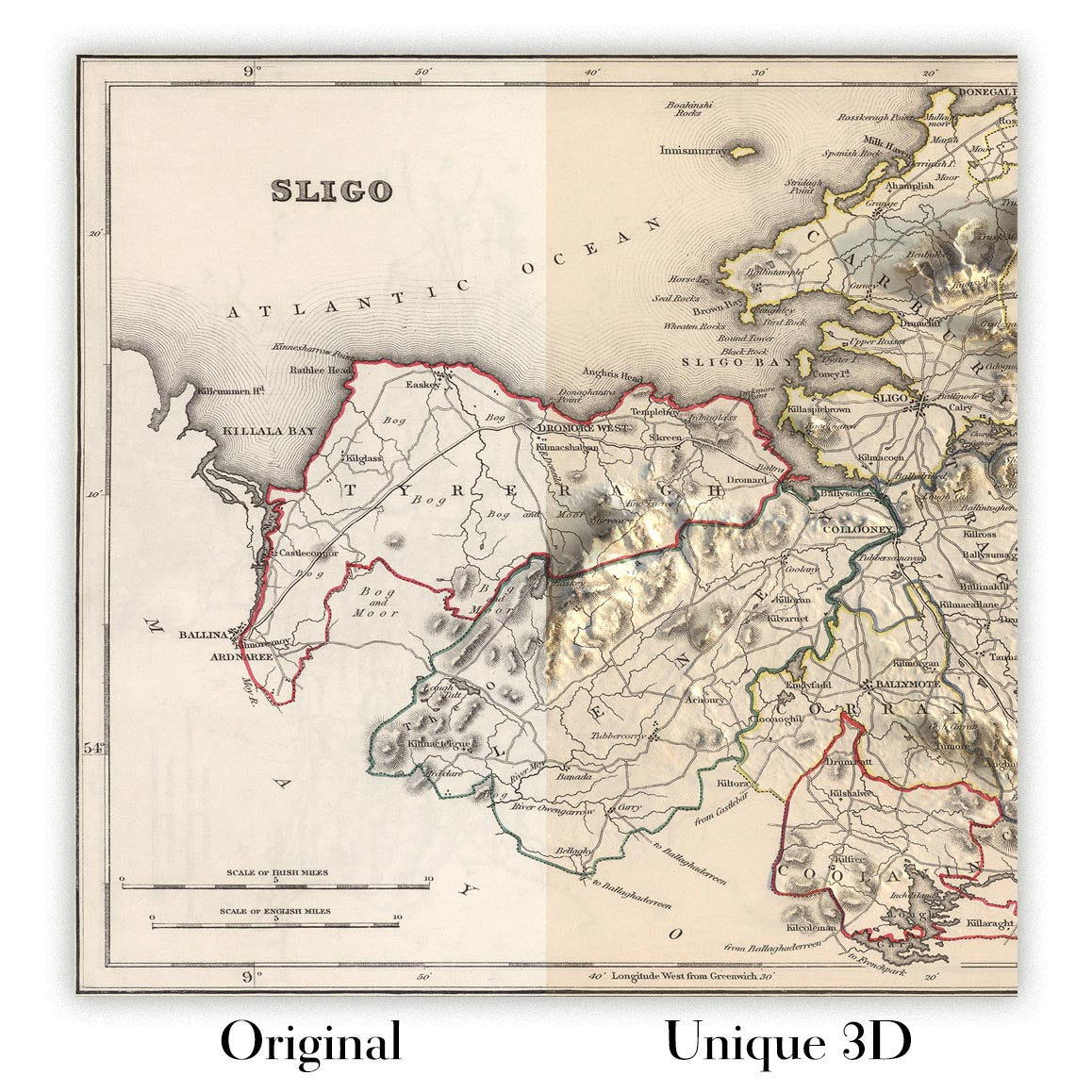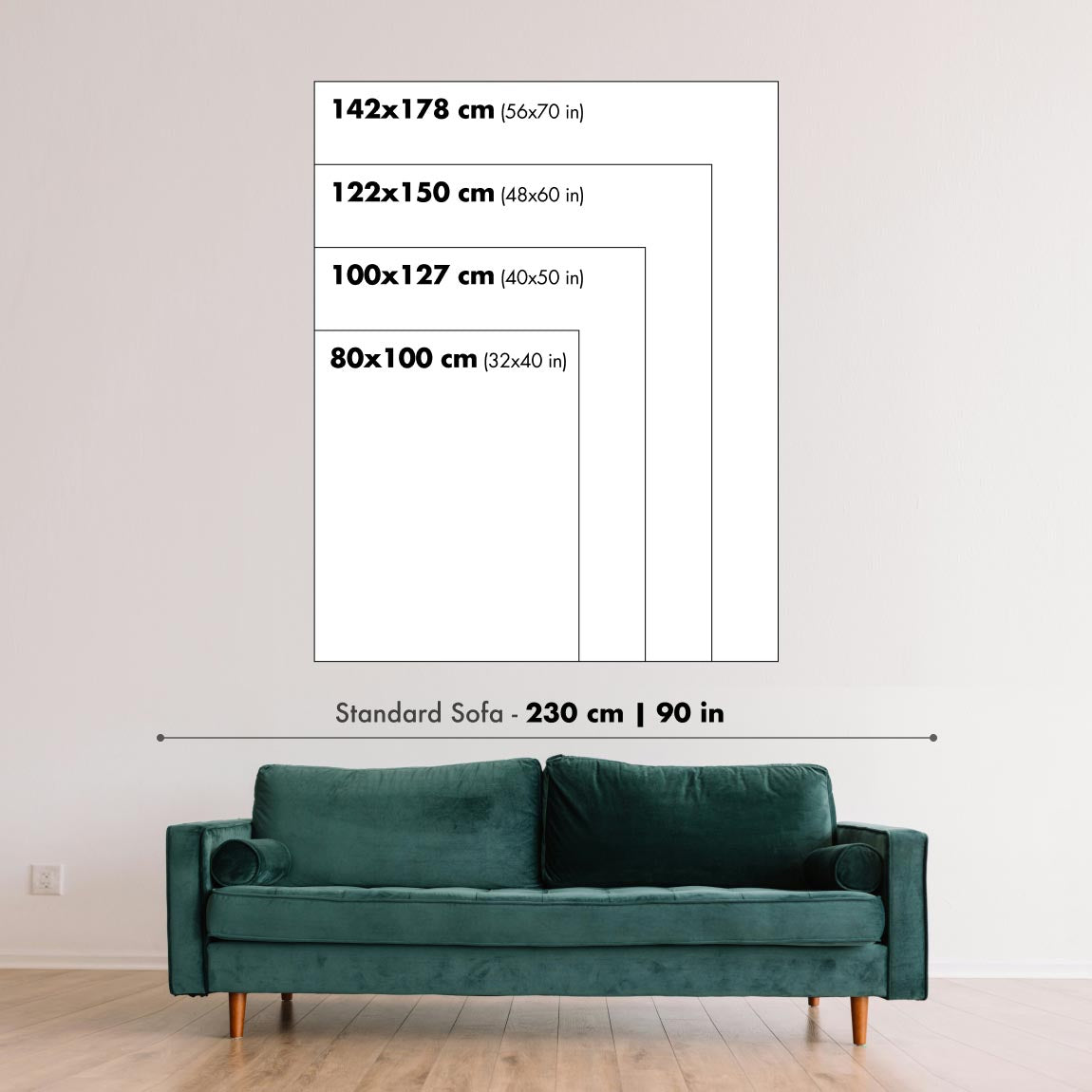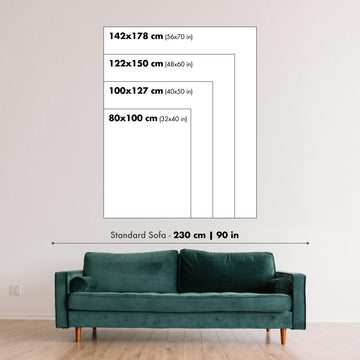- Handmade locally. No import duty or tax
- FREE Delivery by Christmas
- Love it or your money back (90 days)
- Questions? WhatsApp me any time
Own a piece of history
5,000+ 5 star reviews


This Old Map of Derbyshire by Samuel Lewis, created in 1844, showcases the historical charm and intricate details of the county. This map is a captivating piece that allows you to explore the past and discover the fascinating features of Derbyshire. With its rich history and notable landmarks, this map offers a unique perspective on the county's development.
One of the remarkable aspects of this map is its depiction of the major towns, cities, and interesting features of Derbyshire during the mid-19th century. It is important to note that some modern cities may not be present on this map, while others may be listed under earlier names, adding an exciting element of historical discovery. The map's attention to detail provides a glimpse into the past, allowing you to visualize the county as it once was.
Here are 30 notable settlements within the historical boundaries of County of Derbyshire, England, founded before 1840:
- Derby (AD 600): The county town of Derbyshire, known for its industrial heritage and historical landmarks.
- Chesterfield (AD 70): Famous for its crooked spire and market town charm.
- Buxton (AD 79): Renowned for its natural thermal springs and stunning Georgian architecture.
- Ashbourne (AD 1086): A picturesque market town known for its annual Shrovetide football match.
- Matlock (AD 1086): A spa town nestled in the beautiful Derbyshire Dales, attracting visitors with its scenic landscapes.
- Bakewell (AD 949): Home to the delicious Bakewell Pudding and the stunning Chatsworth House.
- Glossop (AD 1290): Surrounded by the Peak District National Park, offering breathtaking views and outdoor activities.
- Alfreton (AD 1086): Historically significant for its coal mining and railway connections.
- Swadlincote (AD 1086): Known for its pottery industry and proximity to the National Forest.
- Long Eaton (AD 500): Situated on the banks of the River Trent, this town has a rich industrial heritage.
- Ilkeston (AD 600): An ancient town with a long history of coal mining and lace making.
- Heanor (AD 1086): Notable for its textile industry and connections to the Robin Hood legend.
- Staveley (AD 1086): A former center of the coal and iron industries, now offering picturesque canal walks.
- Dronfield (AD 1086): Surrounded by beautiful countryside, this town has a rich industrial past.
- Belper (AD 1086): Known for its cotton mills and the UNESCO World Heritage Site, Derwent Valley Mills.
- Ripley (AD 600): A market town with a history of ironworking and coal mining.
- Shirebrook (AD 1086): Once a mining town, now famous for its connections to the sport of boxing.
- Whaley Bridge (AD 1086): Situated in the stunning Peak District, known for its reservoir and outdoor activities.
- Killamarsh (AD 1086): A former coal mining town with a history dating back to Roman times.
- Chapel-en-le-Frith (AD 1225): The highest market town in England, surrounded by the beautiful Peak District.
- New Mills (AD 1391): Located at the confluence of the River Goyt and the River Sett, offering picturesque scenery.
- Wirksworth (AD 1086): A historic market town with a rich mining heritage and beautiful surrounding countryside.
- Clay Cross (AD 1086): Known for its coal mining and connections to the railway industry.
- Sandiacre (AD 1086): Situated on the border with Nottinghamshire, this town has a rich industrial past.
- Duffield (AD 1086): A charming village with a medieval bridge and historical buildings.
- Eyam (AD 862): Famous for its self-imposed quarantine during the bubonic plague outbreak in 1665.
- Hadfield (AD 1086): Located in the scenic Longdendale Valley, offering stunning views of the Peak District.
- Melbourne (AD 1086): A historic market town with a rich architectural heritage and beautiful gardens.
- South Normanton (AD 1086): Known for its coal mining history and proximity to the Derbyshire Dales.
- Tibshelf (AD 1086): A former coal mining village with a history dating back to Roman times.
Notable boundaries, rivers, canyons, national parks, and natural phenomena in County of Derbyshire, England include:
- Peak District National Park: A stunning national park known for its diverse landscapes, including moors, dales, and limestone cliffs.
- River Derwent: A major river that flows through Derbyshire, offering picturesque views and opportunities for outdoor activities.
- Derwent Valley: A UNESCO World Heritage Site, renowned for its historical mills and beautiful scenery.
- Kinder Scout: The highest point in Derbyshire and a popular destination for hikers and nature enthusiasts.
- Dovedale: A picturesque valley in the Peak District, famous for its limestone ravines and stepping stones.
- Mam Tor: Also known as the "Shivering Mountain," this hill offers panoramic views of the surrounding area.
- Stanage Edge: A gritstone escarpment popular among rock climbers and hikers, offering breathtaking views.
Between 1800 and 1850, County of Derbyshire, England witnessed several significant historical events, including:
- Industrial Revolution: Derbyshire played a crucial role in the Industrial Revolution, with the development of coal mining, textile manufacturing, and ironworking industries.
- Luddite Riots: During the early 19th century, the county experienced outbreaks of Luddite protests against the introduction of machinery in the textile industry.
- Growth of Railways: The construction of railway lines, such as the Midland Railway, contributed to the county's industrial and economic growth during this period.
- Reform Act of 1832: This legislation brought about electoral reforms, impacting the political landscape of Derbyshire and the country as a whole.
Owning this Old Map of Derbyshire by Samuel Lewis allows you to delve into the county's history, explore its notable settlements, and appreciate its natural beauty. It is a captivating piece that captures the essence of Derbyshire in 1844.
Please double check the images to make sure that a specific town or place is shown on this map. You can also get in touch and ask us to check the map for you.
This map looks great at all sizes: 12x16in (30.5x41cm), 16x20in (40.5x51cm), 18x24in (45.5x61cm), 24x30in (61x76cm), 32x40in (81.5x102cm) and 40x50in (102x127cm), but it looks even better when printed large.
I can create beautiful, large prints of this map up to 50in (127cm). Please get in touch if you're looking for larger, customised or different framing options.
The model in the listing images is holding the 16x20in (40.5x51cm) version of this map.
The fifth listing image shows an example of my map personalisation service.
If you’re looking for something slightly different, check out my main collection of UK and Ireland maps.
Please contact me to check if a certain location, landmark or feature is shown on this map.
This would make a wonderful birthday, Christmas, Father's Day, work leaving, anniversary or housewarming gift for someone from the areas covered by this map.
This map is available as a giclée print on acid free archival matte paper, or you can buy it framed. The frame is a nice, simple black frame that suits most aesthetics. Please get in touch if you'd like a different frame colour or material. My frames are glazed with super-clear museum-grade acrylic (perspex/acrylite), which is significantly less reflective than glass, safer, and will always arrive in perfect condition.
This map is also available as a float framed canvas, sometimes known as a shadow gap framed canvas or canvas floater. The map is printed on artist's cotton canvas and then stretched over a handmade box frame. We then "float" the canvas inside a wooden frame, which is available in a range of colours (black, dark brown, oak, antique gold and white). This is a wonderful way to present a map without glazing in front. See some examples of float framed canvas maps and explore the differences between my different finishes.
For something truly unique, this map is also available in "Unique 3D", our trademarked process that dramatically transforms the map so that it has a wonderful sense of depth. We combine the original map with detailed topography and elevation data, so that mountains and the terrain really "pop". For more info and examples of 3D maps, check my Unique 3D page.
For most orders, delivery time is about 3 working days. Personalised and customised products take longer, as I have to do the personalisation and send it to you for approval, which usually takes 1 or 2 days.
Please note that very large framed orders usually take longer to make and deliver.
If you need your order to arrive by a certain date, please contact me before you order so that we can find the best way of making sure you get your order in time.
I print and frame maps and artwork in 23 countries around the world. This means your order will be made locally, which cuts down on delivery time and ensures that it won't be damaged during delivery. You'll never pay customs or import duty, and we'll put less CO2 into the air.
All of my maps and art prints are well packaged and sent in a rugged tube if unframed, or surrounded by foam if framed.
I try to send out all orders within 1 or 2 days of receiving your order, though some products (like face masks, mugs and tote bags) can take longer to make.
If you select Express Delivery at checkout your order we will prioritise your order and send it out by 1-day courier (Fedex, DHL, UPS, Parcelforce).
Next Day delivery is also available in some countries (US, UK, Singapore, UAE) but please try to order early in the day so that we can get it sent out on time.
My standard frame is a gallery style black ash hardwood frame. It is simple and quite modern looking. My standard frame is around 20mm (0.8in) wide.
I use super-clear acrylic (perspex/acrylite) for the frame glass. It's lighter and safer than glass - and it looks better, as the reflectivity is lower.
Six standard frame colours are available for free (black, dark brown, dark grey, oak, white and antique gold). Custom framing and mounting/matting is available if you're looking for something else.
Most maps, art and illustrations are also available as a framed canvas. We use matte (not shiny) cotton canvas, stretch it over a sustainably sourced box wood frame, and then 'float' the piece within a wood frame. The end result is quite beautiful, and there's no glazing to get in the way.
All frames are provided "ready to hang", with either a string or brackets on the back. Very large frames will have heavy duty hanging plates and/or a mounting baton. If you have any questions, please get in touch.
See some examples of my framed maps and framed canvas maps.
Alternatively, I can also supply old maps and artwork on canvas, foam board, cotton rag and other materials.
If you want to frame your map or artwork yourself, please read my size guide first.
My maps are extremely high quality reproductions of original maps.
I source original, rare maps from libraries, auction houses and private collections around the world, restore them at my London workshop, and then use specialist giclée inks and printers to create beautiful maps that look even better than the original.
My maps are printed on acid-free archival matte (not glossy) paper that feels very high quality and almost like card. In technical terms the paper weight/thickness is 10mil/200gsm. It's perfect for framing.
I print with Epson ultrachrome giclée UV fade resistant pigment inks - some of the best inks you can find.
I can also make maps on canvas, cotton rag and other exotic materials.
Learn more about The Unique Maps Co.
Map personalisation
If you're looking for the perfect anniversary or housewarming gift, I can personalise your map to make it truly unique. For example, I can add a short message, or highlight an important location, or add your family's coat of arms.
The options are almost infinite. Please see my map personalisation page for some wonderful examples of what's possible.
To order a personalised map, select "personalise your map" before adding it to your basket.
Get in touch if you're looking for more complex customisations and personalisations.
Map ageing
I have been asked hundreds of times over the years by customers if they could buy a map that looks even older.
Well, now you can, by selecting Aged before you add a map to your basket.
All the product photos you see on this page show the map in its Original form. This is what the map looks like today.
If you select Aged, I will age your map by hand, using a special and unique process developed through years of studying old maps, talking to researchers to understand the chemistry of aging paper, and of course... lots of practice!
If you're unsure, stick to the Original colour of the map. If you want something a bit darker and older looking, go for Aged.
If you are not happy with your order for any reason, contact me and I'll get it fixed ASAP, free of charge. Please see my returns and refund policy for more information.
I am very confident you will like your restored map or art print. I have been doing this since 1984. I'm a 5-star Etsy seller. I have sold tens of thousands of maps and art prints and have over 5,000 real 5-star reviews. My work has been featured in interior design magazines, on the BBC, and on the walls of dozens of 5-star hotels.
I use a unique process to restore maps and artwork that is massively time consuming and labour intensive. Hunting down the original maps and illustrations can take months. I use state of the art and eye-wateringly expensive technology to scan and restore them. As a result, I guarantee my maps and art prints are a cut above the rest. I stand by my products and will always make sure you're 100% happy with what you receive.
Almost all of my maps and art prints look amazing at large sizes (200cm, 6.5ft+) and I can frame and deliver them to you as well, via special oversized courier. Contact me to discuss your specific needs.
Or try searching for something!







